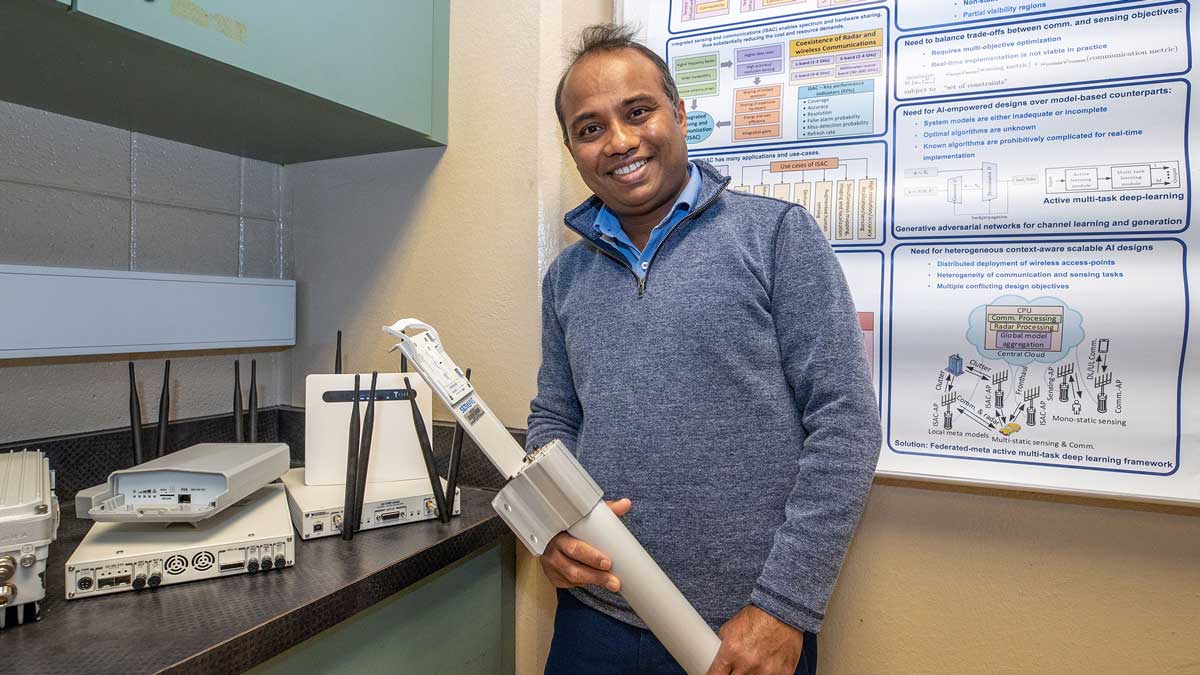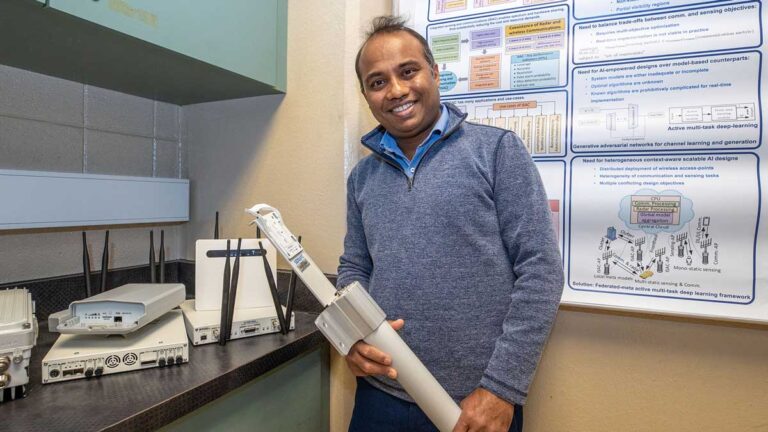
Gayan Alma Baduge, an associate professor in the School of Electrical, Computer and Biomedical Engineering, leads an international research team funded by grants totaling $1.13 million. The three-year project aims to investigate AI-assisted integrated sensing and communications for 6G technology. (Photo: Russell Bailey)
June 3, 2024
SIU researchers lead $1.13 million project to integrate AI into 6G technology
CARBONDALE, Ill. – Imagine a world where highly intelligent wireless systems can monitor the environment to fight pollution, dispatch fleets of vehicles to transport large numbers of people, and help find missing young children because they can identify someone no matter where they are. Sixth-generation wireless (6G) is on the way, and researchers at Southern Illinois University Carbondale are working on the key elements that will make 6G work.
Gayan Alma Baduge, an associate professor in the Department of Electrical, Computer and Biomedical Engineering, leads an international team of researchers funded by grants totaling $1.13 million, including from SIU and Villanova University in the U.S. and Aalto University in Finland.
SIU’s portion of the grant awarded by the National Science Foundation totals $336,500. The three-year project aims to investigate AI-assisted integrated sensing and communications for 6G technology.
“This is a unique research partnership between the European Union and the United States, focusing on developments in the areas of artificial intelligence and integrated sensing and communications,” Baduge said.
In addition to voice and data communications services as used today, 6G technology is expected to also include sensing capabilities such as high-precision location tracking and mapping, area imaging, and autonomous vehicle operation, including “platooning,” where multiple vehicles operate together as a single unit.
Powered and controlled by evolving artificial intelligence, the technology will also be able to perform new surveillance-related functions, such as detecting what gestures and actions humans exhibit and identifying the people performing those actions. For example, the system’s capabilities aim to extract, classify and predict typical human body movements such as standing, sitting, walking, jumping, laughing and crying.
Baduge’s work focuses on developing the theoretical foundations of this technology and designing wireless systems that can integrate mobile communications with environmental imaging and sensing in future wireless systems, combining these systems to improve efficiency and functionality.
“6G wireless systems, which integrate sensing and communication capabilities, will be useful for environmental monitoring, vehicle networks and remote sensing,” Baduge said. “They will also facilitate the construction of smart cities while improving industry, manufacturing and agriculture.”
The key to making 6G live up to its promise is to leverage the similarities between existing wireless sensing and communications systems that already share, or are beginning to share, frequency spectrum, hardware architectures and information processing pipelines.
Baduge hopes to design a structure that formally integrates the two systems into a single hardware platform, using a unified waveform and transmission strategy controlled by AI. Such a system would be significantly more capable of processing signals from a variety of sensors while still handling typical cellular and data transmissions.
System evolution
Historically, radio systems for cellular communications and radar detection were designed and operated independently: they used different waveforms, non-overlapping radio frequency bands, and separate hardware platforms.
Today’s state-of-the-art 5G wireless communications systems are primarily designed and optimized for mobile cellular communications. But the growing demand for higher data rates and more connected wireless devices is driving engineers to use massive antenna arrays operating at higher frequencies, where radar also exists, to meet this demand.
That means it’s starting to get crowded.
“The electromagnetic spectrum and radio frequency bands used for communication and sensing purposes are extremely scarce and expensive resources,” Bajou says. “Integrating communication and sensing tasks onto the same hardware platform can greatly improve efficiency.”
Such a design would also be cost-effective, he said, as expensive radio frequency equipment could be reused for communication and sensing purposes.
Future tasks
The tasks of data communications and radar sensing have competing design goals, making it very difficult to integrate two systems designed for different purposes, Baduge said.
“We therefore propose to use a range of tools, including communication and information theory, estimation and detection, and data-driven artificial intelligence, to overcome the design challenges,” he said.
Baju hopes that the research will help integrate wireless sensing capabilities into 6G technologies, including cellular communication systems, wireless local area networks and industrial Internet of Things networks (such as “smart” homes and appliances), while keeping costs down and conserving frequency spectrum and computing power.


